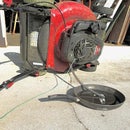Introduction: Pedal Wrench for a Bicycle
I began to feel a little knock in the left pedal on my old 10-speed and thought the bearings may have loosened. But, when I examined it, I saw that the pedal shaft had begun to unscrew itself from the crank. I have a suitable pedal wrench at home, but that bike is kept in another state for times when we visit there. Because I have the necessary tools and scrap materials, I decided to make my own.
Step 1: Cut a Piece of Steel
I have a piece of scrap steel 5/32 inch (4 mm) thick. It is a little harder than most steel and seemed ideal for making a pedal wrench. It is thin enough to fit the narrowest flats on pedals and yet thick enough that it will not bend away.
If it were a long bar, I could simply cut my wrench into one end of the bar. I chose to cut off a piece of steel, form a wrench into it, and weld that to a bar for leverage.
I like to apply a piece of masking tape to steel and mark it with a fine point marker. I am using a cutting wheel in an angle head grinder. My steel is 2 7/16 inch wide. I am cutting a 1 inch piece from it for my wrench. Make it any size you like.
If it were a long bar, I could simply cut my wrench into one end of the bar. I chose to cut off a piece of steel, form a wrench into it, and weld that to a bar for leverage.
I like to apply a piece of masking tape to steel and mark it with a fine point marker. I am using a cutting wheel in an angle head grinder. My steel is 2 7/16 inch wide. I am cutting a 1 inch piece from it for my wrench. Make it any size you like.
Step 2: Cut the Opening for the Flats
I applied a new piece of masking tape and marked the mid-point in the piece of steel. Then I marked two vertical lines to define the sides of the wrench opening. I cut two slots just under 15 mm apart at their outside edges. Most pedal flats accept a 15 mm wrench. Some are 9/16 inch. 9/16 inch is only 0.72 mm less than 15 mm. In a pinch a 15 mm wrench can be used on a 9/16 pedal flat, or add a shim from a very thin piece of a can.
Step 3: Clear Between the Two Cuts
I clamped the portion of the steel I want to use in my vise. I clamped a locking pliers to the part I want to remove and rocked it back and forth until it broke off.
Step 4: Fitting the Wrench to the Flats
My wrench piece was too tight to slide fully onto the pedal flats. I would need to make the opening a little wider, but not by much.
Step 5: Grind Lightly on the Sides of the Opening
Although discouraged, I sometimes do a little light grinding on the side of an abrasive cutting wheel. It made a good way to remove just a little material so I could fit the wrench for the pedal flats as in the previous step. I also gave the bottom of the opening the shape of an arc so it better fits the rounded portion of the pedal shaft.
Step 6: Clamp in Place for Tack Welds
I had a piece of rod 7/16 inch in diameter and 11 inches long that would make a suitable wrench handle. Holding a flat piece of steel in place for tack welding is much easier and more precise when a small spring clamp like the one here is used.
Step 7: Finish the Wrench
After tack welding the wrench head to the steel rod, I removed the spring clamp and changed the wrench's position to make welding easier. I welded both sides and removed the slag.
The heat of welding did narrow the wrench opening just a little and I had to go back to step 5 to size the opening for the flats again.
The heat of welding did narrow the wrench opening just a little and I had to go back to step 5 to size the opening for the flats again.
Step 8: In Use
You can customize your wrench by setting the wrench opening to an angle so the handle has a better mechanical advantage when removing a stubborn pedal. Remember that as you face the outer end of a pedal, the pedal on the right side tightens when the wrench is turned in a clockwise direction, while the pedal on the left side of the bicycle tightens in a counter-clockwise direction.
The heat from welding seems to have softened my steel just a little. Should the steel deform over time from pressure against the flats, I can always add a little weld bead on the affected area and grind it to size again as in step 5.
The heat from welding seems to have softened my steel just a little. Should the steel deform over time from pressure against the flats, I can always add a little weld bead on the affected area and grind it to size again as in step 5.











